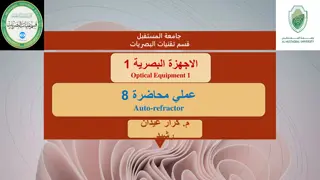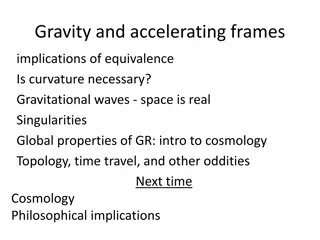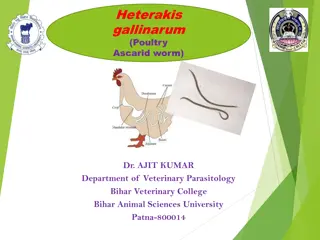Understanding Adrenergic Agents in Pharmaceutical Chemistry
Adrenergic agents play a crucial role in pharmacology by influencing the sympathetic nervous system through adrenergic receptors. These agents, such as sympathomimetics and sympatholytics, impact essential functions like cardiac activity, blood vessel dilation, and insulin release. Adrenergic neurot
0 views • 120 slides
Insights into Tyzzer's Disease: An Overview of a Bacterial Infection in Laboratory Animals
Tyzzer's disease is an acute bacterial infection affecting rodents and rabbits, caused by Clostridium piliforme. Discovered in 1917 by Ernest Tyzzer, the disease is characterized by necrotic lesions in the caecal mucosa, liver, and heart. Initially known as Bacillus piliformis, it was later renamed
2 views • 21 slides
Understanding Special Relativity and Its Implications
Explore the key principles of special relativity, including Galileo's principle of relativity and Einstein's principle of relativity. Dive into concepts like length contraction, momentum and energy conservation, and the invariance of mass-energy. Witness how observers inside and outside moving frame
0 views • 18 slides
Understanding Intestinal Obstruction: Causes, Classification, and Pathophysiology
Intestinal obstruction can be classified into dynamic and adynamic types, with various causes such as intraluminal faecal impaction, malignancy, and hernia. The pathophysiology involves changes in bowel peristalsis and dilation, leading to potential strangulation and ischemia. Morbidity and mortalit
9 views • 40 slides
Caecal Dilation and Torsion in Veterinary Surgery: Causes, Symptoms, Diagnosis, and Treatment
Caecal dilation and torsion is a condition observed in animals like cattle, buffalo, sheep, and goats, characterized by distension, displacement, and twisting of the caecum. This article discusses the etiology, clinical signs, diagnosis, and treatment options for this condition, highlighting the imp
1 views • 12 slides
Effects of Lorentz Transformations: Length Contraction, Time Dilation, and Relativistic Mass
Lorentz transformations have profound consequences in the realm of special relativity. Length contraction results in objects appearing shorter in the direction of motion, with the amount of contraction determined by the Lorentz transformation. Time dilation causes clocks in moving frames to run slow
0 views • 6 slides
Understanding Achalasia: Therapeutic Approaches, Pathophysiology, and Clinical Manifestations
Achalasia is characterized by a failure of the lower esophageal sphincter to relax, leading to difficulty in swallowing and regurgitation. The exact cause is unknown, but autoimmune factors and chronic infections may play a role. Symptoms include dysphagia, chest pain, regurgitation, and weight loss
0 views • 59 slides
Understanding Auto-refractors in Optical Equipment
An auto-refractor is an automated system that uses light reflected off the retina to measure a patient's refractive error objectively. This technology is fast, safe, and easy to use, providing accurate prescriptions without the need for pupil dilation. While children may find it challenging to sit s
0 views • 15 slides
Physics Concepts and Laws Explained
Quantities and units in physics equations, calculation of vector components, laws of motion, conservation of energy, conservation of momentum, impulse, elastic and inelastic collisions, gravitational potential energy, projectile motion, satellite motion, special relativity postulates, time dilation
0 views • 10 slides
Basics of Digital Image Processing in Computer Applications
Understanding digital image processing involves analyzing monochromatic and chromatic images, using morphological operators like erosion and dilation, and utilizing structuring elements. The process includes concepts such as image representation, grey levels, and colour models like RGB. By learning
0 views • 51 slides
Understanding the Physiology of Labor in Pregnancy
Labor, also known as parturition, is the process of uterine contractions leading to the expulsion of the fetus. Various hormonal changes, including increased estrogen levels, play a crucial role in triggering and regulating labor. The progression from a quiescent uterus to active contractions involv
0 views • 29 slides
Impact of Pupil Dilation on Biometric Measurements in Cataract Patients
Cataract surgery requires precise intraocular lens power calculation for optimal refractive outcomes. This study explored the effects of pupil dilation on biometric measurements (such as axial length, corneal power, anterior chamber depth, lens thickness) and IOL power calculation using SS-OCT based
0 views • 7 slides
Exploring the Implications of Gravity and Accelerating Frames in General Relativity
Delve into the fascinating world of General Relativity as we discuss the equivalence principle, gravitational waves, properties of spacetime, and the effects of curvature in the presence of gravity. Discover how Einstein's revolutionary theories have reshaped our understanding of the universe, leadi
0 views • 15 slides
Ascites in Broiler Chickens: Causes, Symptoms, and Management
Ascites is a common disease in broiler chickens, especially at high altitudes. It is characterized by fluid accumulation in the peritoneal cavity or pericardial sac, often containing yellow protein clots. Predisposing factors include reduced ventilation, high altitude, and respiratory disease. Sympt
0 views • 13 slides
Understanding Heterakis Gallinarum: Poultry Ascarid Worm
Heterakis gallinarum, a caecal worm found in domestic and wild birds, plays a role in transmitting Histomonas meleagridis, causing diseases like blackhead in turkeys. Clinical signs include anaemia, diarrhoea, and emaciation. Diagnosis involves microscopic examination, and treatment with fenbendazol
0 views • 10 slides
Managing Intraoperative Floppy Iris Syndrome in Cataract Surgery
Effective management of intraoperative floppy iris syndrome in cataract surgery involves specific maneuvers such as reducing aspiration flow rate, using mechanical iris expansion devices, and avoiding large or posterior incisions. This condition is characterized by progressive pupil constriction, ir
0 views • 6 slides
Understanding Connective Tissues: Characteristics, Classification, and Types
Connective tissues play a crucial role in supporting and connecting various tissues in the body. They are highly vascularized and develop only from mesoderm during embryonic origin. Consisting of cells and intercellular matter secreted by the cells, these tissues are categorized based on cell types
0 views • 109 slides
Understanding Relativity for the GRE Examination
Explore the essential concepts of relativity, mathematics, statistics, and lab methods crucial for the GRE. Delve into special relativity, reference frames, velocity addition, Lorentz transformations, and relativistic collisions. Gain insights into key relationships, relativistic mass, momentum, kin
0 views • 39 slides
Understanding Homotopy and Fundamental Groups in Topology
Explore the concepts of homotopy and fundamental groups in topology, where objects with the same structure can be classified into classes, and the fundamental group characterizes loops. Discover the fundamental group of a torus, its identity elements, closure, associativity, and inverses. Homotopy a
0 views • 10 slides
Pregnancy and the Kidney: Physiological Changes and Considerations for Chronic Kidney Disease
GB, a 28-year-old woman with a history of FSGS, seeks advice on pregnancy. Physiological changes in pregnancy affect renal function, including increased renal flow and volume, ureteral dilation, and systemic vasodilation. Renal hemodynamics peak in the first trimester without causing kidney damage.
0 views • 36 slides
Overview of Operative Vaginal Deliveries and Caesarean Section
Operative vaginal deliveries involve using instruments like forceps or vacuum for delivery, with indications including maternal/fetal distress. Pre-requisites for forceps/ventouse include full cervical dilation. Caesarean sections have a 25% rate with potential complications. Various methods are use
0 views • 13 slides
Understanding Gastrointestinal System Disorders and Endoscopy Procedures
Gastrointestinal (GI) tract disorders are common and can affect various parts of the digestive system. The GI system plays a vital role in ingestion, nutrient absorption, and waste elimination. Endoscopy is a non-surgical procedure used to diagnose and treat GI issues by visualizing the digestive tr
0 views • 42 slides
Understanding the Interpretation of Model Summary Numbers in Pupil Dilation Growth Curve Analysis
When analyzing a growth curve model for pupil dilation, the model summary provides various numbers such as Intercepts, Poly1, Poly2, Condition effects, and interaction terms. Understanding these numbers is crucial for interpreting how pupil dilation is predicted by time and affected by experimental
0 views • 34 slides






















